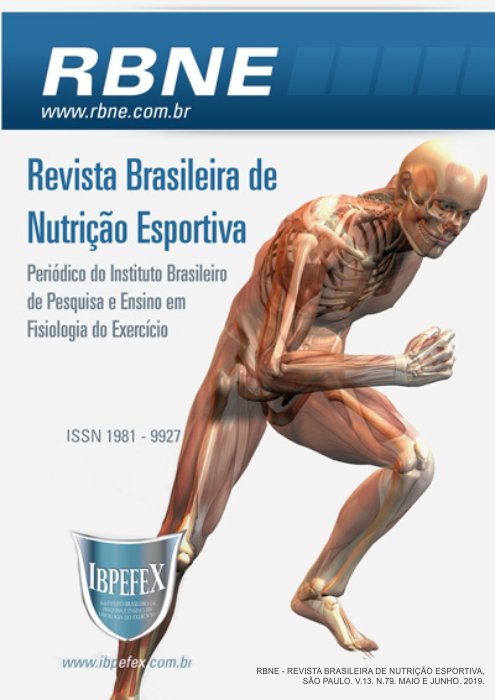Nutritional status and food profile of a female futsal school team from Caxias do Sul-RS municipality
Abstract
Introduction: Futsal, as well as football, has always been recognized as a sport practiced mainly by men. Such culture, for a long time, pushed the girls away from the practice of this modality. Nowadays, it is possible to see the expansion of women's futsal in Brazil: there is a women's futsal department at CBFS; a women's futsal league; a Brazilian women's futsal team; Brazilian club championship in the main category and in the base category. Futsal is a sport that encompasses several ages, including children and adolescents in development, being, in this context, fundamental the nutritional orientation. Objective: To evaluate the nutritional status and feeding profile of a school team of futsal players in the city of Caxias do Sul. Materials and Methods: This was a cross-sectional study. The evaluation of the players was performed by completing the data collection form, food frequency questionnaire and anthropometric evaluation (body mass, height, waist circumference and skinfolds). Data were analyzed descriptively. Results: The results showed that the team is eutrophic and, according to waist circumference, does not present a risk for cardiovascular diseases. The percentage of fat is adequate, and the athletes have good eating habits, although the associations between the studied variables were not statistically significant. Conclusion: The players studied have a balanced diet with a high consumption of vegetables, but also consume candies, breads and pasta with a certain regularity. The importance of the guidelines on adequate and balanced nutrition to improve the physical performance and the health of these players is verified.
References
-Bastos, P. V.; Navarro, A. C. O futsal feminino escolar. Revista Brasileira de Futsal e Futebol. Vol. 1. Núm. 2. 2009. p. 144-162. Disponível em: <http://www.rbff.com.br/index.php/rbff/article/view/18>
-Brasil. Instituto Brasileiro de Geografia e Estatística (IBGE). Pesquisa de Orçamentos Familiares (POF) 2008-2009: antropometria e estado nutricional de crianças, adolescentes e adultos no Brasil. Rio de Janeiro. IBGE. 2010.
-Centers for Desease Control and Prevention. CDC. BMI Percentile Calculator for Child and Teen Metric Version. 2017. Disponível na internet: <https://nccd.cdc.gov/dnpabmi/Calculator.aspx?CalculatorType=Metric>. Acesso em: 1/8/2017.
-Confederação Brasileira de Futebol de Salão (CBFS), 2015. Disponível na internet: <http://www.cbfs.com.br/2015/futsal/origem/index.html>. Acesso em: 29/07/2018.
-Guerra, I.; Soares, E.A.; Burini, R.C. Aspectos nutricionais do futebol de competição. Revista Brasileira de Medicina do Esporte. Rio de Janeiro. Vol. 7. Núm. 6. 2001. p. 200-206.
-International Standards for Anthropometric Assessment. International Society for the Advancement of Kinanthropometry (ISAK), Potchesfstroom: Isak. 2006. p. 145.
-Leme, M.G.A.; Kuada, E.C.; Márcia, N. M.; Reis, V. Avaliação nutricional de atletas juvenis de handebol feminino. Movimento & Percepção, Espírito Santo do Pinhal, São Paulo. Vol. 10. 2009. Núm. 14. 2009, p.5 -12.
-Levy, R.B.; Castro I.R.R.; Cardoso, L.O; Tavares, L.F; Sardinha, L.M.V; Gomes, F.B; Costa, A.W.N. Consumo e comportamento alimentar entre adolescentes brasileiros: Pesquisa Nacional de Saúde do Escolar (PeNSE), 2009. Ciência & Saúde Coletiva. Núm. 15. 2010. p. 3085-3097.
-McCarthy, H.D.; Jarrett, K.V.; Crawley, H.F. The development of waist circumference percentiles in Britishchildren aged 5.0-16.9 y. European Journal of Clinical Nutrition. Núm. 55. 2001. p. 902-907.
-Pereira, P.F.; Serrano, H.M.S.; Carvalho, G.Q.; Lamounier, J.A.; Peluzio, M.C.G.; Franceschini, S.C.C.; Priore, S.L. Circunferência da cintura como indicador de gordura corporal e alterações metabólicas em adolescentes: comparação entre quatro referências. Revista da Associação Médica Brasileira. Minas Gerais. Vol. 6. Núm. 6. 2010. p. 665-669.
-Queiroga, R.M.; Ferreira, A.S.; Romanzini, M. Perfil antropométrico de atletas de futsal feminino de alto nível competitivo conforme a função tática desempenhada no jogo. Revista Brasileira de Cineantropometria e Desempenho Humano. Vol. 7. Núm. 1. 2005. p. 30-34.
-Quintão D.F.; Oliveira G.C.; Silva S.A.; Marins J.C.B. Estado nutricional e perfil alimentar de atletas de futsal de diferentes cidades do interior de Minas Gerais. Revista Brasileira de Futebol. Vol. 2. Núm. 1. 2009. p. 13-20.
-Rodrigues, B.; Spuldaro, L.I.; Biesek, S. Intervenção nutricional em atletas adolescentes praticantes de futsal de uma associação atlética de Curitiba-PR. Revista Brasileira de Nutrição Esportiva. São Paulo. Vol. 10. Núm. 56. 2016, p. 126-135. Disponível em: <http://www.rbne.com.br/index.php/rbne/article/view/571>
-Santana, W.C.; Reis, H.H.B. Futsal Feminino: perfil e implicações pedagógicas. Revista Brasileira Ciência e Movimento. Vol. 11. Núm. 4. 2003. p. 45-50.
-Silveira, M.A.; Rombaldi, A.J.; Coswig, V.S. Efeitos de uma intervenção alimentar em atletas de futsal de diferentes categorias etárias. Revista Brasileira de Futsal e Futebol. São Paulo. Vol. 9. Núm. 32. 2017. p. 70-76. Disponível em: <http://www.rbff.com.br/index.php/rbff/article/view/456>
-Slaughter, M.H.; Lohman, T.G.; Boileau, R.A.; Horswill, C.A.; Stillman, R.J.; Van Loan, M.D. et al. Skinfold equations for estimation of body fatness in children and youth. Human Biology. Vol. 60. Núm. 5. 1988. p. 709-723.
-Soares, B.M.; Chagas, M.E.E.; Sehnem, R.C.; CíricoD. Avaliação da ingestão calórica e composição corporal de atletas de futsal feminino do município de Guarapuava-Paraná. Revista Brasileira de Futsal e Futebol. São Paulo. Vol. 8. Núm. 29. 2016. p. 129-141. Disponível em: <http://www.rbff.com.br/index.php/rbff/article/view/401>
-Tavares, L.F; Castro I.R.R.; Levy, R.B.; Cardoso, L.O; Claro, R.M. Padrões alimentares de adolescentes brasileiros: resultados da Pesquisa Nacional de Saúde do Escolar (PeNSE). Cadernos de Saúde Pública. Rio de Janeiro. 2014. p. 1-13.
Authors who publish in this journal agree to the following terms:
- Authors retain the copyright and grant the journal the right of first publication, with work simultaneously licensed under the Creative Commons Attribution License BY-NC which allows the sharing of the work with acknowledgment of the authorship of the work and initial publication in this journal.
- Authors are authorized to enter into additional contracts separately for non-exclusive distribution of the version of the work published in this journal (eg, publishing in institutional repository or book chapter), with acknowledgment of authorship and initial publication in this journal.
- Authors are allowed and encouraged to post and distribute their work online (eg, in institutional repositories or on their personal page) at any point before or during the editorial process, as this can bring about productive change as well as increase impact and impact. citation of published work (See The Effect of Free Access).






